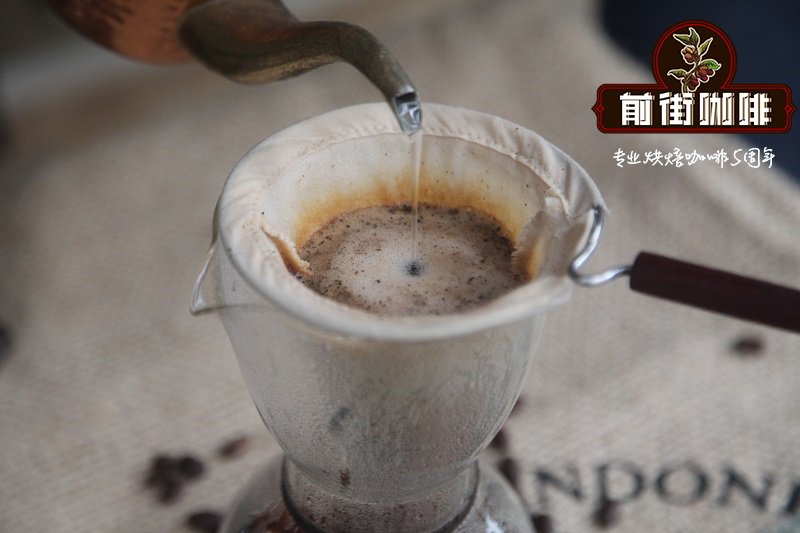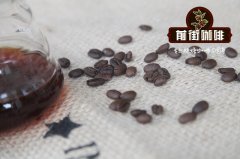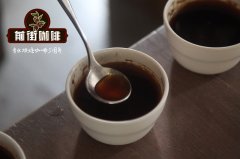Insufficient coffee extraction? Excessive extraction? How to know by tasting? How do you judge?

Professional coffee knowledge exchange More coffee bean information Please pay attention to coffee workshop (Weixin Official Accounts cafe_style)
Insufficient coffee extraction? Excessive extraction? How do you know by tasting? How?
This article links basic coffee extraction theory to coffee that tastes "over-extracted,""under-extracted," and "ideally extracted."
Extraction is arguably the most important but least understood part of coffee brewing. Extraction stands for everything. If you can't even get a cup of coffee without extraction, here's the simplest but not 100% accurate statement:
Extraction is the extraction of coffee substances with water.
Everything is easy to talk about, but much harder to understand and apply.
Let's not discuss the effects of coffee oil and trace components in extraction in depth here. Let's discuss more practical and relevant information, such as how to taste extracted coffee and become proficient. As for chemical analysis, we will talk about it later.
A lot happens when coffee is mixed with water, and the easiest way to put it is that the water dissolves a lot of the coffee flavor, which is almost the flavor you drink in your coffee cup. Only ground coffee powder will affect the taste, but the fine powder is not considered during extraction, because the fine powder is only floating in water during extraction.
Roasted coffee beans have about 28% by weight of matter that is soluble in water, which means that about 28% of coffee beans can be extracted into water. The rest of the material is almost all fiber and seed tissue of coffee beans. Water is a good medium for soluble substances, but it still needs some help. If the whole coffee beans are thrown into hot water, the extracted substances are much less than powder, because the structure of coffee beans is very dense and complex, and water cannot pass through the whole coffee beans and dissolve the flavor. So we have to increase the surface area of the coffee bean, we have to "open it" so that the water can bring out the taste of coffee. Extraction is facilitated by the use of a bean grinder, which grinds coffee beans into powder and increases the surface area for water to work.
Ideally, we grind coffee to a very fine state, drop it in water and dissolve it into a wonderful flavor. Unfortunately, if you do this, it is a very bitter cup of coffee. Not all coffee flavors are good, so we have to control the amount of flavor extracted to make a delicious cup of coffee.
Similarly, we can't grind a lot of coffee beans and extract a little bit. To avoid these over-extracted flavors, under-extracted coffee tastes just as terrible (sometimes worse than over-extracted coffee). Most people understand that extraction is like a two-way street, and we always try to find a balance on this street, avoiding over-extraction or under-extraction.
The following simple diagram explains what happens next, and when you can harness it, you can make your coffee richer. And until then, we were all still stopping at the intersection represented in the picture below.
1. Insufficient coffee extraction
Insufficient extraction means that the coffee powder is not enough, and there are many residual substances in the coffee powder that can increase the flavor of the cup of insufficient extraction. Imagine a cup of short-lived espresso, known as a premium espresso ristretto, with a sour smell, a lack of sweetness, a strange salty taste and a disappointingly short aftertaste. These four characteristics are obvious signs of underextraction, so let's take a closer look at the phenomenon of underextraction.
prickly sour
The acidity of coffee can be tricky, especially if the coffee's acidity is expected. Many people ask the author,"Isn't sourness the same as acidity?" This is a good question; many languages use the same word for sour as for acid, and you can imagine how difficult it is for speakers of different languages to test together.
To clarify this part, we define prickly acidity as a negative taste. The tongue will quickly and strongly feel the sour taste, which will cause an immediate physiological reaction. You may wrinkle your lips or have an electric shock or sharp feeling on both sides of your tongue. Sour taste can be unpleasant and spoil your palate, and it's not the taste you want.
When it comes to acid, it can be good or bad, and acid is more like a flavor than a good word. For example,"The acidity of coffee is pleasant," or "The acidity of this coffee is high," is logical. Acid and sour/juicy/acid bright/irritating acid These can be linked, you can write an article about acid, but this article is about extraction. Back to business.
lack of sweetness
From the author's point of view, the most important thing about coffee flavor is sweetness. Sweet is the best. Have you ever heard someone complain like that?" This coffee is too sweet!" Let's think about it, I'm pretty sure we're all after the sweetness of coffee. Sweet taste is like the Holy Grail that is very hard to find, and once found, there are amazing rewards! Insufficient extraction is not sweet, and far apart. Lack of extraction can show post-coffee dissatisfaction, giving people the feeling of emptiness I want more coffee. It is worth mentioning that the lack of sweetness can highlight the sour taste of coffee beans and make people feel the lack of extraction more obviously.
salty
Not everyone agrees with the author at this point, but this section must insist that under-extracted coffee will be salty. It's not like "sorry I put salt in my coffee," it's like coffee that's not extracted enough, and it almost always tastes salty. To the touch, it's like the slippery sensation of contact with alkaline food (please don't drink ammonia to feel it, trust me).
#SCIENCE LEARN-Sour and salty substances dissolve more easily than sweet, which is why under-extracted coffee has sour and salty substances, and sweet substances do not have enough time or opportunity to dissolve completely.
Short finish
The aftertaste of a well-extracted coffee can last for minutes (or even hours, if you're lucky). Imagine someone putting brown sugar on your tongue, or imagine you've just eaten a delicious toffee.
Under-extracted coffee has no such aftertaste. When you swallow coffee, the flavor dissipates. There will be no pleasant sensations left in your mouth, which allows you to experience the coffee that leaves you feeling short-lived and unsatisfactory, unpleasant and unpalatable.
There are other bad feelings that represent inadequate extraction, but these four items are more obvious and definite. Whenever you drink these characteristics, you can be sure that you are drinking coffee that is under-extracted.
Let's move on to the other extreme of underextraction.
Over-extracted coffee
Over-extracted coffee means that too much soluble matter is brought out of coffee, and this extraction results in bad flavor.
Imagine a cup of premium espresso with an extraction time of 40-50 seconds. Don't pretend you haven't had this over-extracted coffee. This coffee will be bitter, dry and hollow, which are the three most obvious characteristics of over-extracted coffee. Let's look at these characteristics again.
bitter taste
We've all had bitter coffee. Over-extracted coffee is really bitter, and unless I'm drinking Campari bitters, I don't want to drink it that bitter. Much of the bitterness comes from caffeine, but bitterness is also linked to many other chemical processes. Deep-roasted coffee reaches a charred state and forms more bitter chemicals.
#Science Lecture-There are thousands of chemicals (mostly poisons) that trigger bitter signals in our taste buds, warning our bodies not to eat them.
dryness
It is very uncomfortable to drink coffee that feels dry in coffee, because the dry feeling is very strong and will last for a long time. This feeling is called astringency, just like when you drink unsweetened black tea, new wine, or over-brewed white wine. The astringency in the wine is due to the polyphenol effect: chemicals found in plants, seeds and bark, which may also be responsible for the dryness of coffee.
Polyphenols are bitter and combine with proteins in your saliva, which is commonly understood as drying your tongue and producing a rustiness or dryness in your mouth (this should not be confused with "crunchy" and "dry" in wine, adjectives that indicate distinct acidity or low sweetness, not necessarily taste).
hollow feeling
The author likes to describe over-extracted coffee as empty. Coffee feels empty and lifeless, just like extracting the light from coffee and killing the good stuff in the process. Coffee with good extraction will leave you with a rich, delicious, smooth and mouth-watering taste. Over-extracted coffee is hollow, coarse, and obnoxious bland. It is this lack of flavor and character (and this character does not refer to flavor characteristics) that leads the author to describe it as empty.
These are the taste characteristics of over-extracted flavors, and there are certainly more adjectives, but these are the easiest to recognize, which also reminds you not to rush over-extracted coffee.
The most important thing about these vacuous flavors is that they are common and can be extracted from the world's noblest Rosedale coffee, as well as from inferior, harsh coffee. These flavors are not pleasing, and most of the people reading this article are looking for specialty coffee, which means we try to create special coffee for consumers so that consumers will pay more to taste it, and the error of insufficient extraction is so abrupt.
Now for the good stuff, sweet, delicious coffee.
3. Good extracted coffee
A good coffee extract is something that can only be found once in a while, and we invest a lot of effort in balancing countless variables to create a cup of coffee that tastes good, and we have to know how it tastes.
Imagine the best coffee you've ever had, sweet and ripe! The clarity of the flavor is like transparency. Acid is balanced and positive, and if you're lucky, acid is rich and has a long finish. It's the coffee that gets people going, and the coffee that you want to know more about.
Sweet and mature
The author has spent countless hours and pains to extract more of coffee's most mature flavor from coffee.
Imagine a plum or similar stone fruit ripening, initially rich and intensely acidic, then sweeter as it matures, and the sugar content of the fruit developing and becoming richer, thicker, and even greasy. Then you reach a point where it's like you hold fruit close to your nose and smell sweet. This is the sweet and ripe flavor you want from coffee, and if you've never had coffee like this, you'll probably be easily satisfied.
Clarity and transparency
George Howell describes coffee preparation as "peeping through the coffee window", and the author likes to stretch this sentence to "imagine extraction and roasting as the other panes of the coffee window", if the coffee in your cup is over-extracted or under-extracted coffee, you will have a hard time "seeing" the actual flavor of the coffee. Common extraction mistakes can distract you and waste the effort you put into tasting coffee at the front end.
sour
Fine, rich and distinct acidity is the most important element behind coffee. Acid is intoxicating but also demoralizing, and when you drink coffee, acid makes you think of certain fruits and even wine. If the acid can be clearly defined, you can focus on remembering how you felt the last time you ate the fruit.
Long aftertaste
The meaning of its own words to explain everything, good aftertaste can be retained for a long time, that is, one of the symbols of good coffee extraction.
So that's coffee extraction and flavor good, bad or worse, hopefully now you can notice these coffee you normally drink and be able to link to coffee characteristics of different extraction results.
Important Notice :
前街咖啡 FrontStreet Coffee has moved to new addredd:
FrontStreet Coffee Address: 315,Donghua East Road,GuangZhou
Tel:020 38364473
- Prev

The finer the coffee powder, will it be bitter when it is made by hand at high temperature? Is the fine powder good to make coffee by hand?
Professional coffee knowledge exchange more coffee bean information Please pay attention to the coffee workshop (Wechat official account cafe_style) the finer the coffee powder, the high temperature and rapid manual brewing will be bitter? Is the fine powder good to make coffee by hand? The following five records are for reference and comparison only, for the brewing practice of fine powder. I like the taste of D and B very much. If you are interested, you can fine-tune and test it by yourself. It is recommended to use a small amount of fine powder.
- Next

What are the phenomena and causes of the cooking process? What kind of steaming? How do you cook it?
Professional coffee knowledge exchange more information about coffee beans Please follow the phenomena and causes of the brewing process in the coffee workshop (Wechat official account cafe_style). What kind of steaming? How do you cook it? 1. Steaming phenomenon: expand into a hill when hot water is poured in, the gas in the coffee powder expands due to heat (coffee powder enlarges, it will look like a honeycomb, with many gaps), the gas expands.
Related
- Detailed explanation of Jadeite planting Land in Panamanian Jadeite Manor introduction to the grading system of Jadeite competitive bidding, Red bid, Green bid and Rose Summer
- Story of Coffee planting in Brenka region of Costa Rica Stonehenge Manor anaerobic heavy honey treatment of flavor mouth
- What's on the barrel of Blue Mountain Coffee beans?
- Can American coffee also pull flowers? How to use hot American style to pull out a good-looking pattern?
- Can you make a cold extract with coffee beans? What is the right proportion for cold-extracted coffee formula?
- Indonesian PWN Gold Mandrine Coffee Origin Features Flavor How to Chong? Mandolin coffee is American.
- A brief introduction to the flavor characteristics of Brazilian yellow bourbon coffee beans
- What is the effect of different water quality on the flavor of cold-extracted coffee? What kind of water is best for brewing coffee?
- Why do you think of Rose Summer whenever you mention Panamanian coffee?
- Introduction to the characteristics of authentic blue mountain coffee bean producing areas? What is the CIB Coffee Authority in Jamaica?

